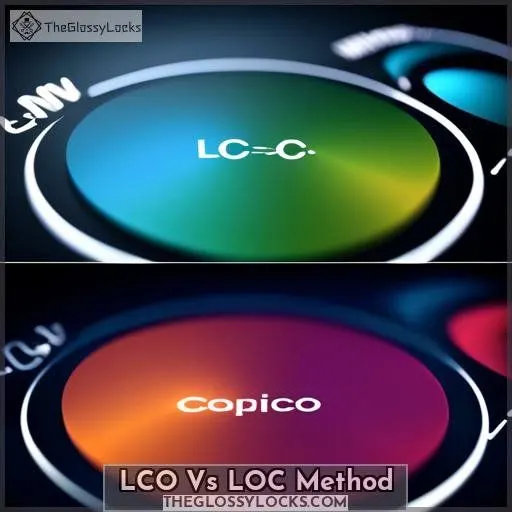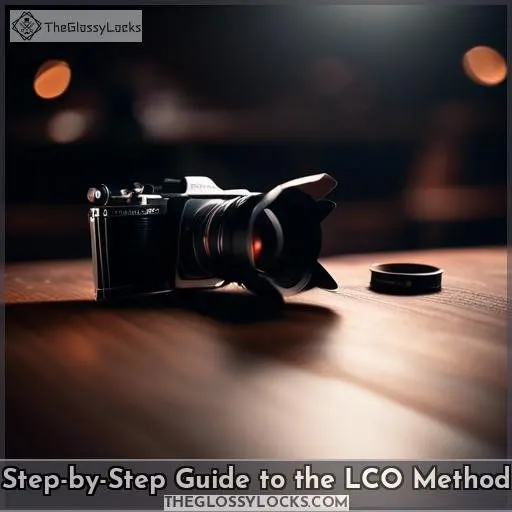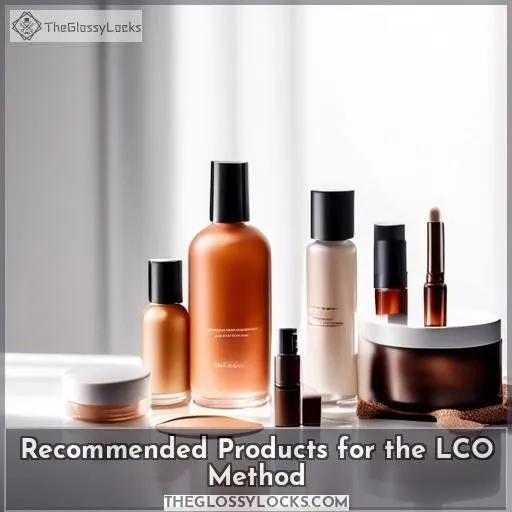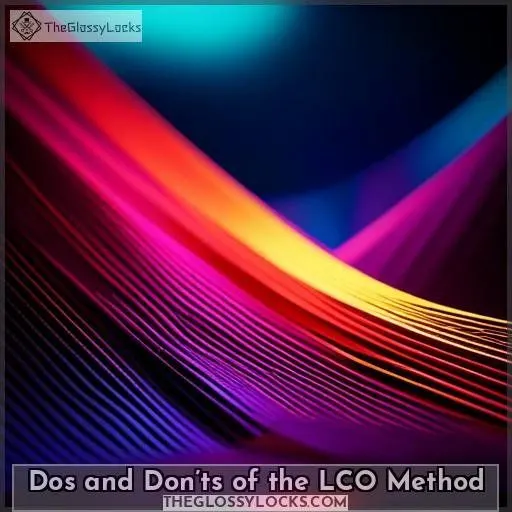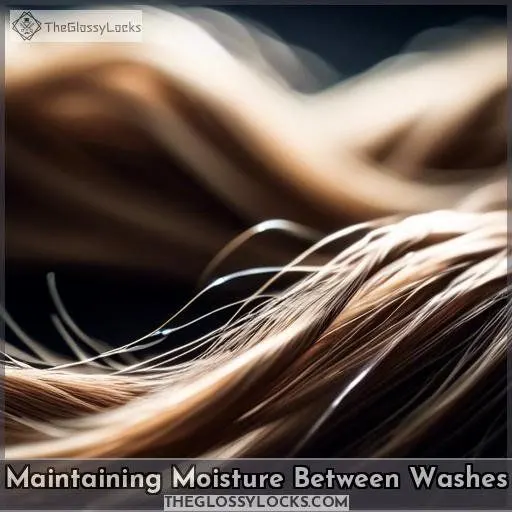This site is supported by our readers. We may earn a commission, at no cost to you, if you purchase through links.
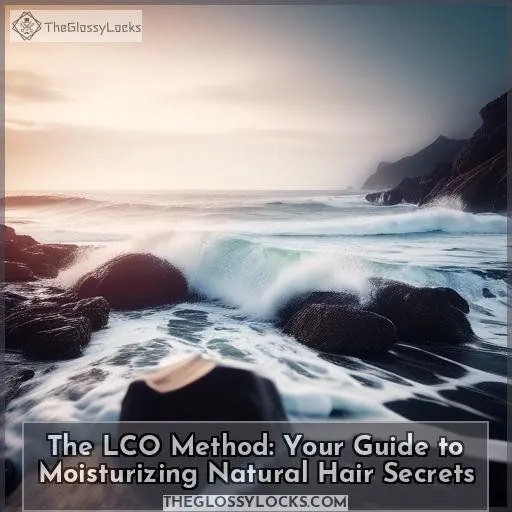
The LCO method is a powerful way to hydrate and nourish your natural hair. It involves applying a liquid, cream, and oil in that specific order to seal in moisture. The liquid step opens your cuticles to allow the oil to deeply penetrate, while the cream and oil steps lock in that much-needed hydration.
This method is ideal for those with low porosity hair, as it focuses on penetration rather than just sealing the surface. By following the LCO method, you’ll enjoy enhanced moisture retention, defined curls, and reduced frizz.
Table Of Contents
- Key Takeaways
- Understanding the LCO Method
- LCO Vs LOC Method
- Benefits of the LCO Method
- Who Should Use the LCO Method
- Step-by-Step Guide to the LCO Method
- Recommended Products for the LCO Method
- Dos and Don’ts of the LCO Method
- Troubleshooting Common Issues
- Maintaining Moisture Between Washes
- Frequently Asked Questions (FAQs)
- What are the benefits of the LCO method for hair health?
- How does the LCO method differ from the LOC method in terms of product application order?
- What is the best hair porosity level for the LCO method?
- How can I troubleshoot common issues with the LCO method, such as product buildup or lack of moisture retention?
- Can the LCO method be used for different hair types and porosity levels, or is it specifically designed for a certain type?
- Conclusion
Key Takeaways
- The LCO method is a popular hair care technique for naturalists, focusing on hydration and improving workability in kinky, coily, and curly hair.
- It involves applying a liquid, cream, and oil in that specific order to seal in moisture, with each step contributing to the overall goal of keeping the moisture in the hair strands.
- The LCO method is ideal for those with low porosity hair, as it focuses on penetration rather than just sealing the surface.
- By following the LCO method, you’ll enjoy enhanced moisture retention, defined curls, and reduced frizz.
Understanding the LCO Method
The LCO (Liquid, Cream, Oil) method is a popular hair care technique used by naturalistas to maintain hydration and improve workability in their hair. This method is particularly useful for those with kinky, coily, and curly hair, which tends to have difficulty retaining hydration. The LCO method involves applying a liquid, cream, and oil to your hair in that order, with each step contributing to the overall goal of keeping the moisture in the hair strands.
- Liquid: The first step is to apply a water-based liquid or leave-in conditioner to your hair. This step helps to hydrate the hair and open up the cuticles, making it easier for the oil to penetrate the hair shaft.
- Cream: The second step is to apply a cream or lotion to your hair. This step acts as a sealant, helping to lock in the hydration from the liquid and prevent it from evaporating. The cream should be applied evenly throughout your hair, focusing on the ends, which tend to be more prone to dryness.
- Oil: The final step is to apply a lightweight oil to your hair. This step seals in the hydration from the cream and helps to prevent further hydration loss. It’s essential to choose an oil that’s suitable for your hair type and porosity, as some oils can be heavier than others and may weigh down your hair.
The LCO method is suitable for various hair types, including type 4 hair (A, B, C), thin hair, and all porosity levels. It’s particularly beneficial for those with high porosity hair, as it helps to keep the hydration in the hair shaft for longer. However, it’s essential to be careful with the oil selection, as low porosity hair may benefit more from a lighter oil to avoid overloading the hair with product.
When using the LCO method, it’s essential to maintain a consistent hair care routine, moisturizing every other day to ensure your hair remains hydrated. This method can help reduce frizz, improve workability, and promote length retention when combined with protective or low manipulation styling.
LCO Vs LOC Method
The LOC and LCO methods differ in the order of product application, with the LOC method applying oil before cream and the LCO method applying cream before oil. Depending on your hair type and porosity, one method may work better than the other in keeping your natural hair moisturized.
Key Differences
The LCO method, which stands for liquid, cream, and oil, is a popular approach to moisturizing natural hair. This method is ideal for low porosity hair, which has difficulty absorbing products.
The key difference between LCO and LOC (liquid, oil, cream) is the order of product application. LCO applies oil before cream, while LOC applies cream before oil. Both methods aim to retain moisture, but the LCO method focuses on penetration, while the LOC method seals in moisture from the surface.
The LCO method involves using a leave-in conditioner, followed by a lightweight cream, and finally, a moisturizing oil.
Choosing the Right Method for Your Hair
Choosing the right method for your hair isn’t rocket science, but it does require a bit of know-how. Think of your hair as a unique canvas—what works for one masterpiece mightn’t for another. It’s all about understanding your hair’s texture, porosity, and what you’re aiming to achieve. Let’s break it down with a quick table to guide you:
| Hair Texture | Hair Porosity | Recommended Method |
|---|---|---|
| Fine/Medium | High | LCO |
| Coarse | Low | LOC |
| Mixed | Mixed | Experiment |
| Curly | High | LCO |
| Kinky | Low | LOC |
Benefits of the LCO Method
Embrace the LCO Method for its exceptional abilities in hydrating and nourishing your natural hair. Here are three important advantages:
- Moisture Retention: The LCO Method guarantees that your hair remains hydrated by sealing in moisture with a nourishing cream and locking it in with hair oil.
- Curl Definition: This method aids in defining your curls, giving them a more pronounced and resilient appearance.
- Frizz Reduction: By sealing in moisture, the LCO Method substantially reduces frizz, leaving your hair with a soft and healthy shine.
Witness the transformative power of the LCO Method and discover the secrets to moisturized, defined curls.
Who Should Use the LCO Method
The LCO Method is perfect for those with low porosity hair, as it uses lightweight products that absorb easily into the hair. This method is also beneficial for those who struggle with moisture retention and frizz reduction, as it helps to seal in moisture and protect against humidity.
Some recommended products for the LCO Method include castor oil, coconut oil, olive oil, flaxseed oil, and styling butter. By following the LCO Method, you can achieve healthy, hydrated natural hair that looks and feels great.
Step-by-Step Guide to the LCO Method
Wash your hair using a sulfate-free shampoo and conditioner to prep it for the LCO method. Next, apply a leave-in conditioner from root to tip, evenly distributing it throughout your strands.
Washing Your Hair
To wash your hair using the LCO method, start by thoroughly cleansing your hair with a sulfate-free shampoo and conditioner. Rinse your hair until it’s soaking wet.
Next, apply a generous amount of leave-in conditioner from root to tip. This step hydrates your hair and prepares it for the next steps.
Then, apply a lightweight hair cream evenly throughout your hair. This product will add a layer of moisture and help protect your hair from damage.
Finally, seal in the moisture with a few drops of hair oil, focusing on the roots and ends. This will create a protective barrier that helps retain moisture and prevent frizz.
Remember to wash your hair every other day to maintain hydration.
Applying Leave-in Conditioner
Applying leave-in conditioner is a vital step in the LCO method. Start by thoroughly saturating your hair with a dime-sized amount of product per section, focusing on the ends and roots. Sectioning your hair makes application effortless.
Choose a product like grapeseed oil or argan oil for lightweight, quickly-absorbed options. For a wash and go style, flaxseed oil curling cream is an excellent choice for taming frizz.
Applying Hair Cream
When applying hair cream, think of it as arming each strand against summer’s harsh siege. Section your hair for a strategic product application, ensuring no strand is left behind. Aim for hair saturation with just a dime-sized amount per section to avoid breakage.
Among the recommended products, Design Essentials and Jane Carter Solution are like trusted shields for your hair’s defense.
Sealing With Hair Oil
To seal your hair with oil in the LCO method, follow these steps:
- Choose a lightweight, penetrating oil that’s suitable for your hair type. Examples include Kate Blanc Cosmetics 100% Pure Cold Pressed Organic Argan Hair Oil or other oils like jojoba, almond, or grapeseed oil.
- Apply the oil to your hair after using a leave-in conditioner and hair cream. Focus on the ends and roots of your hair, as these areas are more prone to dryness and breakage.
- Use a dropper or your fingers to apply a few drops of oil to each section of your hair. Be sure to distribute the oil evenly to avoid weighing down your hair.
- Allow the oil to absorb into your hair for a few minutes before styling or going out in the sun.
When choosing an oil for the LCO method, consider the following factors:
- Penetration: Choose an oil that can penetrate the hair shaft, such as a penetrating oil like argan oil or jojoba oil.
- Absorption: Opt for an oil that absorbs well into your hair, as this will help to lock in moisture and prevent product buildup.
- Layering: If you prefer the LCO method over the LOC method, consider using a penetrating oil like argan oil as your final step.
Recommended Products for the LCO Method
Finding the right leave-in conditioner, hair cream, and hair oil can make or break your LCO routine. Try mixing and matching different products to see which combination works best for moisturizing and sealing your natural hair.
Leave-in Conditioners
Enter the realm of leave-in conditioners, your secret weapon for maintaining luxurious tresses. Here are four exceptional options for your LCO method:
- Design Essentials Natural Almond & Avocado Leave-In: Nourish your hair with this almond and avocado-infused conditioner.
- Jane Carter Solution Nourishing Cream: Greet soft, hydrated curls with this lightweight, creamy formula.
- Mielle Organics Mint Almond Oil: Infused with peppermint and almond oil, this conditioner leaves your hair feeling refreshed and revitalized.
- Ella’s Concoctions Quickie Oil: This rapidly absorbed oil-conditioner hybrid is ideal for sealing in moisture without burdening your hair.
Hair Creams
Hair creams are an indispensable part of the LCO method, which stands for Liquid (leave-in conditioner), Cream, and Oil. They help define curls, enhance luster, reduce breakage, and control frizz. When applying hair cream in the LCO method, follow these guidelines:
- Cream application: Apply a generous amount of hair cream to your hair, focusing on the ends and any areas that tend to be drier or more prone to frizz.
- Defining curls: Use your fingers or a comb to distribute the cream evenly throughout your hair, ensuring that each curl is coated.
- Enhancing luster: Allow the cream to sit for a few minutes to allow it to penetrate your hair and enhance its natural shine.
- Reducing breakage: The cream helps to protect your hair from damage, reducing the likelihood of breakage.
- Controlling frizz: The cream helps to seal in moisture, preventing frizz and keeping your hair looking smooth and healthy.
Some recommended hair creams for the LCO method include:
- Curls Blueberry Bliss Twist-N-Shout Cream: Ideal for adding hydration and definition to low-porosity curls.
- Kate Blanc Cosmetics 100% Pure Cold Pressed Organic Argan Hair Oil: A lightweight cream that helps to define curls and add shine.
- Mielle Organics Pomegranate and Honey Twisting Souffle: A popular choice for those with low porosity hair, as it helps to seal in moisture and define curls.
- Camille Rose Naturals Almond Jai Twisting Butter: A rich, buttery cream that helps to control frizz and add shine to curls.
- Bounce Curl Avocado and Rose Oil Clump and Define Cream: A lightweight cream that helps to define curls and add shine without weighing down your hair.
Remember to apply the cream after your leave-in conditioner and before your oil in the LCO method. This order allows the cream to penetrate your hair and seal in moisture, while the oil helps to lock in the hydration and add shine.
Hair Oils
Embrace the power of hair oils in the LCO method! These precious elixirs nourish your strands, hydrating your hair and protecting your scalp. Here are five recommended oils to enhance your routine:
- Jojoba Oil: A carrier oil that mimics your scalp’s natural oils
- Castor Oil: A thick, emollient oil that coats strands and promotes growth
- Argan Oil: A lightweight, non-greasy oil that softens and conditions
- Coconut Oil: A versatile oil that penetrates strands and protects from damage
- Tea Tree Oil: A potent essential oil that stimulates the scalp and fights dandruff
Dos and Don’ts of the LCO Method
After zeroing in on the perfect products for the LCO method, let’s nail down the dos and don’ts to guarantee your hair’s thirst is thoroughly quenched. Remember, rules are more like guidelines, and there’s always room for a little twist in the tale.
| Do’s | Don’ts | Exceptions |
|---|---|---|
| Use lightweight products | Overload with heavy oils | Thick hair may need more |
| Apply in small sections | Skip the liquid step | Spritz water if rushed |
| Seal with your favorite oil | Use silicones that block moisture | Some silicones are water-soluble |
Stick to these, and you’ll be the master of your mane’s destiny.
Troubleshooting Common Issues
Troubleshooting Common Issues with the LCO Method
The LCO method is a popular hair care routine for natural hair types, but like any hair care technique, it’s not without its challenges. Here are some common issues you might encounter and how to address them:
- Product Overload: Using too many products can weigh down your hair and make it look greasy. To prevent this, stick to the recommended products and use them in the correct order.
- Lack of Moisture: If your hair still feels dry after using the LCO method, you may need to adjust the amount of product you’re using or try different products that work better for your hair type.
- Frizziness: If your curls are frizzy after using the LCO method, it could be due to a lack of moisture or the wrong product combination. Try using a heavier oil or a different leave-in conditioner to help combat frizz.
- Build-up: Over time, using too many products can lead to product build-up on your hair. To prevent this, make sure to cleanse your hair regularly and avoid using too many products at once.
To guarantee the best results with the LCO method, follow these best practices:
- Choose the right products: Not all products are suitable for all hair types. Make sure to select products that are specifically designed for your hair type and porosity.
- Apply products in the correct order: Always apply your products in the correct order: liquid, cream, oil.
- Use the right amount of product: Don’t overdo it. Use the recommended amount of product for your hair type and length.
- Cleanse regularly: Regularly cleanse your hair to remove product build-up and maintain its health.
If you’re still experiencing issues, consider trying alternative hair care methods or consulting a hair care professional for personalized advice.
Maintaining Moisture Between Washes
To maintain moisture between washes, focus on daily maintenance. Moisturize every other day with leave-in hydration, cream absorption, and oil sealing. This routine keeps your hair moisturized and manageable. Remember, the LCO method is your secret weapon for natural hair care.
Frequently Asked Questions (FAQs)
What are the benefits of the LCO method for hair health?
You’ll love how the LCO method nourishes your hair, locking in moisture and taming frizz for smoother, more manageable locks. It’s the secret to healthy, vibrant hair that turns heads!
How does the LCO method differ from the LOC method in terms of product application order?
The key difference between the LCO and LOC methods is the order of application – LCO applies cream before oil, while LOC applies oil before cream. This simple tweak can make all the difference in achieving your hair’s sweet spot.
What is the best hair porosity level for the LCO method?
The LCO method works best for folks with low-porosity hair. Since low-porosity strands struggle to absorb moisture, the lightweight products in the LCO routine soak in easily, keeping your mane quenched and frizz-free.
How can I troubleshoot common issues with the LCO method, such as product buildup or lack of moisture retention?
Encounter product overload? Tame the tangles! Switch it up – lighten the load with a breezy LCO routine. Unleash hair freedom; conquer moisture woes with this proven technique, customized just for you.
Can the LCO method be used for different hair types and porosity levels, or is it specifically designed for a certain type?
The LCO method can work for various hair types and porosity levels, from fine strands to thick coils. The key is choosing lightweight, hydrating products that absorb easily without weighing down your tresses. Feel free to experiment to find your sweet spot!
Conclusion
Ah, the LCO method – the secret to moisturizing natural hair that’ll have you looking like a goddess, darling. By following this simple step-by-step guide, you’ll be locking in hydration, taming frizz, and releasing those luscious curls.
Don’t be a square, give the LCO method a try and bid farewell to dry, dull strands. Your hair will thank you, honey.
So, what are you waiting for? Immerse yourself in the LCO method and let your locks flourish!


